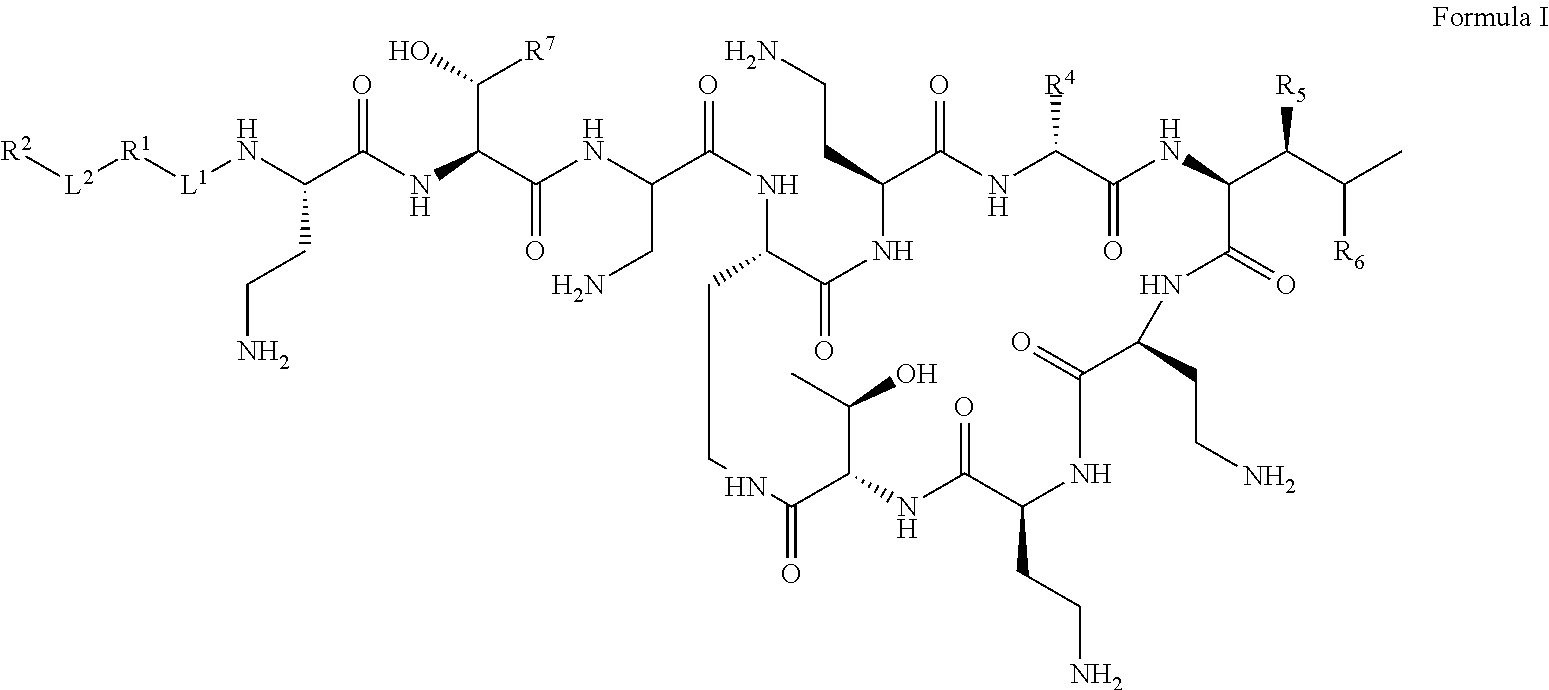Polymyxin Derivates Useful As Antibacterial Agents
a technology of polymyxin and derivatives, which is applied in the direction of antibacterial agents, biocides, peptide/protein ingredients, etc., can solve the problems of requiring discontinuation, complicating a patient's therapy, and causing renal toxicity, and achieve the effect of simplifying administration
- Summary
- Abstract
- Description
- Claims
- Application Information
AI Technical Summary
Benefits of technology
Problems solved by technology
Method used
Image
Examples
example 46
[0613]Example 46 was prepared using a similar procedure as described for Example 1 except that L-serine was used instead of L-threonine at the two (2) position. 1H NMR (500 MHz, D2O) δ 8.84 (d, J=5.69 Hz, 1H), 8.42 (d, J=0.86 Hz, 1H), 8.03 (dd, J=1.62, 5.74 Hz, 1H), 7.93 (dd, J=1.83, 7.66 Hz, 2H), 7.70-7.60 (m, 3H), 7.42-7.28 (m, 3H), 7.24 (d, J=7.10 Hz, 2H), 4.85-4.78 (m, 2H), 4.60-4.50 (m, 2H), 4.47 (dd, J=5.47, 8.89 Hz, 1H), 4.32-4.12 (m, 6H), 3.98 (dd, J=5.43, 11.37 Hz, 1H), 3.89 (dd, J=5.72, 11.38 Hz, 1H), 3.53 (dd, J=5.02, 13.43 Hz, 1H), 3.39-3.25 (m, 2H), 3.25-2.99 (m, 9H), 2.92-2.82 (m, 1H), 2.81-2.72 (m, 1H), 2.42-2.30 (m, 1H), 2.30-2.06 (m, 5H), 2.06-1.78 (m, 4H), 1.52-1.43 (m, 1H), 1.43-1.33 (m, 1H), 1.15 (d, J=6.39 Hz, 3H), 0.89-0.77 (m, 1H), 0.75 (d, J=6.26 Hz, 3H), 0.68 (d, J=6.18 Hz, 3H); HRMS: (M+2H)+2 608.8331; Calcd 608.8329.
example 47
[0614]Example 47 was prepared using a similar procedure as described for Example 1 except that D-Dap was used instead of L-Dap at the three (3) position. 1H NMR (500 MHz, D2O) δ 8.78 (d, J=5.70 Hz, 1H), 8.40-8.29 (m, 1H), 7.96 (dd, J=1.64, 5.70 Hz, 1H), 7.92-7.81 (m, 2H), 7.65-7.54 (m, 3H), 7.33-7.21 (m, 3H), 7.18-7.10 (m, 2H), 4.79-4.72 (m, 2H), 4.50 (t, J=8.18 Hz, 1H), 4.41 (d, J=3.68 Hz, 1H), 4.36 (dd, J=5.51, 8.82 Hz, 1H), 4.34-4.27 (m, 1H), 4.24-4.11 (m, 5H), 4.08 (d, J=4.67 Hz, 1H), 3.49 (dd, J=5.59, 13.40 Hz, 1H), 3.33-3.21 (m, 2H), 3.21-3.11 (m, 2H), 3.11-2.90 (m, 7H), 2.86-2.75 (m, 1H), 2.75-2.64 (m, 1H), 2.39-2.27 (m, 1H), 2.27-2.00 (m, 5H), 2.00-1.74 (m, 4H), 1.47-1.37 (m, 1H), 1.37-1.28 (m, 1H), 1.18 (d, J=6.37 Hz, 3H), 1.09 (d, J=6.39 Hz, 3H), 0.83-0.72 (m, 1H), 0.69 (d, J=6.33 Hz, 3H), 0.62 (d, J=6.24 Hz, 3H). HRMS: (M+2H)+2 615.8408; Calcd 615.8407.
example 48
[0615]Example 48 was prepared using a similar procedure as described for Example 3 except that L-isoleucine was used instead of L-leucine at the seven (7) position. 1H NMR (500 MHz, D2O) δ 8.73 (dd, J=0.88, 5.30 Hz, 1H), 8.13 (dd, J=0.86, 1.55 Hz, 1H), 7.93-7.87 (m, 1H), 7.82-7.76 (m, 1H), 7.74 (dd, J=1.63, 5.33 Hz, 1H), 7.55-7.46 (m, 2H), 7.35-7.28 (m, 2H), 7.28-7.22 (m, 1H), 7.19 (d, J=6.81 Hz, 2H), 4.77-4.63 (m, 3H), 4.43 (d, J=3.90 Hz, 1H), 4.38-4.34 (m, 1H), 4.30-4.22 (m, 2H), 4.22-4.06 (m, 5H), 3.46 (dd, J=5.04, 13.44 Hz, 1H), 3.32-2.89 (m, 11H), 2.78-2.68 (m, 1H), 2.68-2.58 (m, 1H), 2.38-2.00 (m, 6H), 1.94-1.69 (m, 5H), 1.19-1.13 (m, 4H), 1.09 (d, J=6.18 Hz, 3H), 0.97-0.84 (m, 1H), 0.76-0.69 (m, 3H), 0.65 (d, J=6.83 Hz, 3H). HRMS: (M+2H)+2 632.8212; Calcd 632.8213.
PUM
| Property | Measurement | Unit |
|---|---|---|
| concentration | aaaaa | aaaaa |
| pore-size | aaaaa | aaaaa |
| diameter | aaaaa | aaaaa |
Abstract
Description
Claims
Application Information
 Login to View More
Login to View More - R&D
- Intellectual Property
- Life Sciences
- Materials
- Tech Scout
- Unparalleled Data Quality
- Higher Quality Content
- 60% Fewer Hallucinations
Browse by: Latest US Patents, China's latest patents, Technical Efficacy Thesaurus, Application Domain, Technology Topic, Popular Technical Reports.
© 2025 PatSnap. All rights reserved.Legal|Privacy policy|Modern Slavery Act Transparency Statement|Sitemap|About US| Contact US: help@patsnap.com



